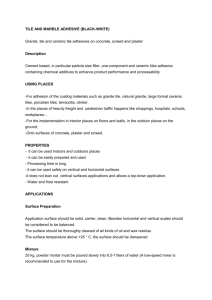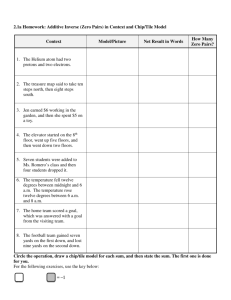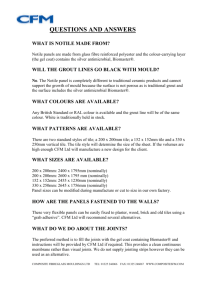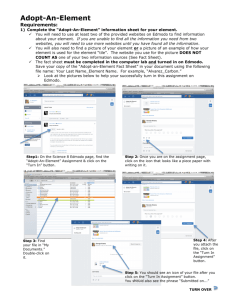thuật ng tds 136 t ngữ ngành công nghiệp gp gạch
advertisement
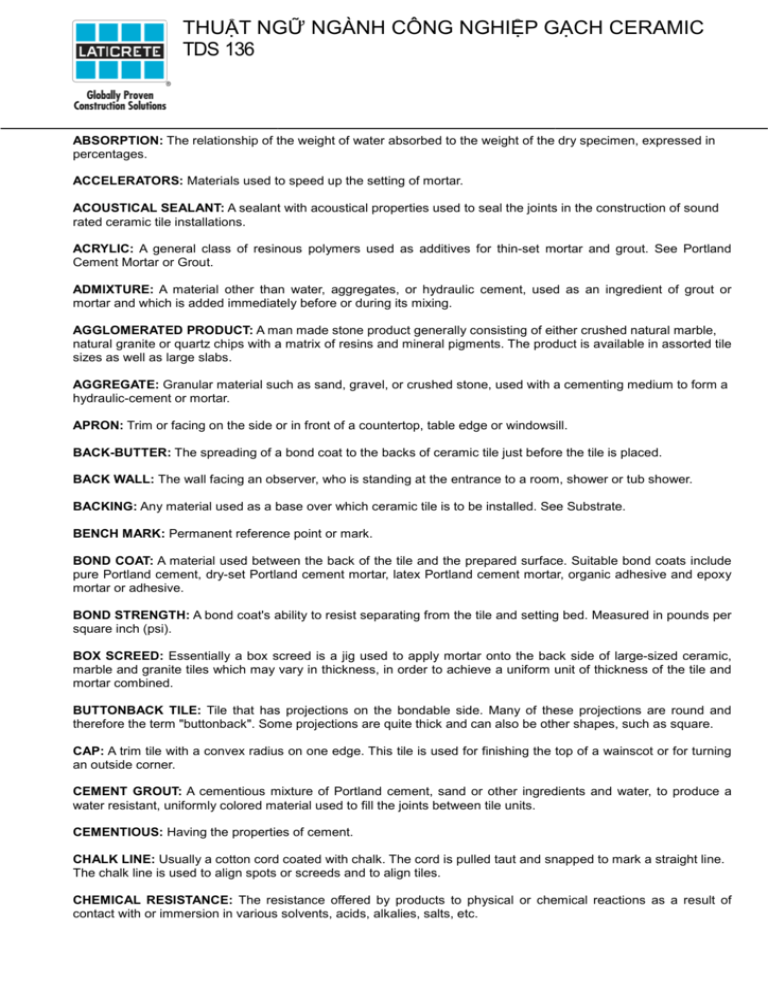
THUẬT T NGỮ NG NGÀNH CÔNG NGHIỆP P GẠCH G CERAMIC TDS 136 ABSORPTION: The relationship of the weight of water absorbed to the weight of the dry specimen, expressed in percentages. ACCELERATORS: Materials used to speed up the setting of mortar. ACOUSTICAL SEALANT: A sealant with acoustical properties used to seal the joints in the construction of sound rated ceramic tile installations. ACRYLIC: A general class of resinous polymers used as additives for thin-set set mortar and grout. See Portland Cement Mortar or Grout. ADMIXTURE: A material other than water, aggregates, or hydraulic cement, used as an ingredient of grout or mortar and which is added immediately before or during its mixing. AGGLOMERATED PRODUCT: A man made stone product generally consisting of either crushed natural marble, natural granite or quartz chips with a matrix of resins and mineral pigments. The product is available in assorted tile sizes as well as large slabs. AGGREGATE: Granular material such as sand, gravel, or crushed stone, used with a cementing medium to form a hydraulic-cement or mortar. APRON: Trim or facing on the side or in front of a countertop, table edge or windowsill. BACK-BUTTER: The spreading of a bond coat to the backs of ceramic tile just before the tile is placed. BACK WALL: The wall facing an observer, who is standing at the entrance to a room, shower or tub shower. BACKING: Any material used as a base over which ceramic tile tile is to be installed. See Substrate. BENCH MARK: Permanent reference point or mark. BOND COAT: A material used between the back of the tile and the prepared surface. Suitable bond coats include pure Portland cement, dry-set set Portland cement mortar, latex Portland cement mortar, organic adhesive and epoxy mortar or adhesive. BOND STRENGTH: A bond coat's ability to resist separating from the tile and setting bed. Measured in pounds per square inch (psi). BOX SCREED: Essentially a box screed is a jig used to apply mortar onto the back side of large-sized large ceramic, marble and granite tiles which may vary in thickness, in order to achieve a uniform unit of thickness of the tile and mortar combined. BUTTONBACK TILE: Tile that has projections on the bondable side. side. Many of these projections are round and therefore the term "buttonback". Some projections are quite thick and can also be other shapes, such as square. CAP: A trim tile with a convex radius on one edge. This tile is used for finishing the top of a wainscot wai or for turning an outside corner. CEMENT GROUT: A cementious mixture of Portland cement, sand or other ingredients and water, to produce a water resistant, uniformly colored material used to fill the joints between tile units. CEMENTIOUS: Having the properties of cement. CHALK LINE: Usually a cotton cord coated with chalk. The cord is pulled taut and snapped to mark a straight line. The chalk line is used to align spots or screeds and to align tiles. CHEMICAL RESISTANCE: The resistance offered by products to physical or chemical reactions as a result of contact with or immersion in various solvents, acids, alkalies, salts, etc. THUẬT T NGỮ NG NGÀNH CÔNG NGHIỆP P GẠCH G CERAMIC TDS 136 CLEAVAGE MEMBRANES: A membrane that provides a separation and slip-sheet slip sheet between the mortar setting bed and the backing or base surface. CLINKER (KLINKER): Red body formed by either the extrusion process or dust pressing. Sometimes referred to as red stoneware. This tile can be glazed or unglazed with a water absorption of 0.7%. COLD JOINT: Any point in concrete construction where a pour was terminated and the surface lost its plasticity before work was continued. COLORED GROUT: Commercially prepared grout consisting of carefully graded aggregate, Portland cement, water dispersing agents, plasticizers and color fast pigments. COMPACTION: The process whereby the volume of freshly placed mortar or concrete is reduced to the minimum practical space usually by vibration, centrifugation, tamping or some combination of these; to mold it within forms or molds and around und imbedded parts and reinforcement and to eliminate voids other than entrained air. COMPRESSIVE STRENGTH: A material's ability to withstand a load measured in psi. CONDUCTIVE MORTAR: A tile mortar to which specific electrical conductivity is imparted through t the use of conductive additives. COPING: The material or units used to form a cap or finish on top of a wall, pier, pilaster or chimney. COVE: A trim tile unit having one edge with a concave radius. A cove is used to form a junction between the bottom wall course and the floor or to form an inside corner. COVE BASE (Sanitary): A trim tile having a concave radius on one edge and a convex radius on the opposite edge. This base is used as the only course of tile above the floor tile. CRAWLING: A parting and contraction of the glaze on the surface of ceramic ware during drying or firing, which results in unglazed areas bordered by coalesced glaze. glaze CRAZING: The cracking that occurs in fired glazes or other ceramic coatings due to critical tensile stresses (minute surface cracks). CURING: Maintenance of humidity and temperature of the freshly placed mortar or grout during some definite period following lowing the placing or finishing, to assure satisfactory hydration of Portland cement and proper hardening of the mortar or grout. CUSHION-EDGED TILE: Tile on which the facial edges have a distinct curvature that results in a slightly recessed joint. DASH COAT: A first coat of mortar sometimes applied to a smooth surface with a whisk broom or fiber brush in such a manner as to provide a good mechanical key for subsequent mortar coats. DOT-MOUNTED TILE: Tile packaged in sheet format and held together by by plastic or rubber dots between the joints. DRY-SET MORTAR: A mixture of Portland cement with sand and additives imparting water retentivity, which is used as a bond coat for setting tile. Normally, when this mortar is used, neither the tile nor the walls have to be soaked during installation. EFFLORESCENCE: The residue deposited on the surface of a material (usually the grout joint) by crystallization of soluble salts. ELASTOMERIC: Any of various elastic substances resembling rubber. EPOXY ADHESIVE: An adhesive system employing epoxy hardener portions. EPOXY GROUT: A mortar system employing epoxy resin and epoxy hardener portions. THUẬT T NGỮ NG NGÀNH CÔNG NGHIỆP P GẠCH G CERAMIC TDS 136 EPOXY MORTAR: A system employing epoxy resins and hardener portions, often containing coarse silica filler and which is usually formulated for industrial and commercial installations installations where chemical resistance is of paramount importance. EPOXY RESIN: An epoxy composition used as a chemical resistant setting adhesive or chemical resistant grout. EXPANSION JOINT: A joint through the tile, mortar and reinforcing wire down to the substrate. subst EXTRUDED TILE: A tile unit that is formed when plastic clay mixtures are forced through a pug mill opening (die) of suitable configuration, resulting in a continuous ribbon of formed clay. A wire cutter or similar cut-off cut device is then used to cut the ribbon into appropriate lengths and widths of tile. FAN or FANNING: Spacing tile joints to widen certain areas so they will conform to a section that is not parallel. FLOAT COAT: The final mortar coat over which the neat coat, pure coat or skim coat is applied. FLOAT STRIP: A strip of wood about 1/4 inch thick and 1-1/4 1 1/4 inches wide. It is used as a guide to align mortar surfaces. FLOATING: A method of using a straightedge to align mortar with float strips or screeds. Specialists use this technique when they are setting glass mosaic murals. FURAN GROUT: An intimate mixture of a Furan resin, selected fillers and an acid catalyst. Fillers are generally carbon, silica or combination thereof into which the acid catalyst, or setting agent, may be incorporated. When combined, the components form a trowelable material for buttering or pointing tile. FURAN RESIN: A chemical resistant acid catalyzed condensation reaction product from furfural alcohol, furfural or combinations thereof. FURRING: Stripping used to build out a surface such as a studded wall. Strips of suitable size are added to the studs to accommodate vent pipes, shower pans, tubs or other fixtures. GLASS MESH MORTAR UNIT/CEMENTITIOUS BACKER UNIT: A backer board designed for use with ceramic tile in wet areas. It can be used in place of metal lath, Portland cement scratch coat and mortar bed. GRADE: A predetermined degree of slope that t a finished floor should have. GRADES: Grades of tile recognized in ANSI standard specifications for ceramic tile. GROUT: A cementitious or other type material used for filling joints between tile. GROUTING: The process of filling tile joints with grout. gr GROUT SAW: The grout saw is saw-toothed saw toothed carbide steel blade mounted on a wooden handle. It is used to remove old grout. It is also used in patching work. Care should be taken as it can easily damage adjacent tiles. The carbide steel blade is brittle and it will shatter if it is dropped or abused. HARD SCREED: A mortar screed that has become firm. HORIZONTAL BROKEN JOINTS: A style of laying tile with each course offset one-half one half its length. HOT-MOPPED PAN: A type of shower pan made of altering layers of hot asphalt and tarpaper. IMPERVIOUS TILE: Tile with water absorption of 0.5 percent or less. IN/OUT CORNERS: Trim tile for turning a right-angle right inside or outside a wall corner. L CUT: A piece of tile cutt or shaped to the letter "L". LAITANCE: A layer of weak and non-durable non durable material containing cement and fines from aggregates, brought by THUẬT T NGỮ NG NGÀNH CÔNG NGHIỆP P GẠCH G CERAMIC TDS 136 bleeding water to the top of overwet concrete, the amount of which is generally increased by overworking or overmanipulating pulating concrete at the surface by improper finishing or by job traffic. LATEX-PORTLAND PORTLAND CEMENT GROUT: Combines Portland cement grout with a special latex additive. LATEX-PORTLAND PORTLAND CEMENT MORTAR: A mixture of Portland cement, sand and a special latex additive addi that is used as a bond coat for setting tile. LATH: Metal mesh which acts as a backing or reinforcing agent for the scratch coat or mortar. LAYOUT LINES: Lines chalked on a substrate to guide in accurately setting tile. LAYOUT STICK: A long strip of wood marked at the appropriate joint intervals for the tile to be used. It is used to check the length, width or height of the tile work. Common names for this item are "idiot stick" or "story pole". LEG: A tile wall running alongside a bathtub or abutment. This term is sometimes used to describe a narrow strip of tile floor. LUGS: Protuberances attached to tiles to maintain even spacing for grout lines. MARBLE TILE: Marble cut into tiles, usually 3/8 inch to 3/4 inch thick. Available in in various finishes; including polished, honed and split face. MASTER GRADE CERTIFICATE: A certificate which states that the tile listed in the shipment and described on the certificate are made in accordance with ANSI A137.1. MASTIC: Tile adhesives. MORTAR BED: The layer of mortar on which tile is set. The final coat of mortar on a wall, floor or ceiling is called a mortar bed. MUD: A slang term for mortar. NEAT CEMENT: Portland cement mixed with water to a desired creamy consistency. See Pure Coat. Coa NOMINAL SIZES: The approximate facial size or thickness of tile, expressed in inches or fractions of an inch. NON-VITREOUS TILE: Tile with water absorption of more than 7.0 percent. NOTCHED TROWEL: A trowel with a serrated or notched edge. It is used for the application of a gauged amount of tile mortar or adhesive in ridges of a specific thickness. OPEN TIME: The period of time during which the bond coat retains its ability to adhere to the tile and bond the tile to the substrate. ORGANIC ADHESIVE: A prepared organic material, ready to use with no further addition of liquid or powder, which cures or sets by evaporation. PAPER AND WIRE: Tarpaper and wire mesh (or metal lath) that are used as a backing for the installation of tile. PENCIL ROD: Reinforcing rod with a diameter of no greater than 1/4 inch. PINHOLES: Imperfections in the surface of a ceramic body or glaze, or in the surface of a grout. wh mixed with a PLASTER: A cementitious material or combination of cementitious material and aggregate that, when suitable amount of water, forms a plastic mass or paste which when applied to a surface, adheres to it and subsequently hardens, preserving in a rigid state the form or texture imposed during the period of plasticity; also the placed and hardened mixture. PLUMB: Perpendicular to a true level. THUẬT T NGỮ NG NGÀNH CÔNG NGHIỆP P GẠCH G CERAMIC TDS 136 PLUMB SCRATCH: An additional scratch coat that has been applied to obtain a uniform setting bed on a plumb vertical plane. POT LIFE: The period of time during which a material maintains its workable properties after it has been mixed. PREFLOAT: The term used to describe mortar that has been placed and allowed to harden prior to bonding tile to it with thin-set materials. psi: Pounds per square inch. PURE COAT: Neat cement applies to the mortar bed. bed RACK: A metal grid that is used to properly space and align tiles. RAKE or RAKE LINE: The inclination from a horizontal direction. RECEPTOR: Waterproof base for a shower stall. REFERENCE LINES: A pair of lines chalked on a substrate that intersect at 90 degree angle and establish the starting point for plotting a grid of layout lines to guide in accurately setting tile. RETURN: The ending of a small splash wall or wainscot at right angles to the the major wall. RODDING: A method of using a straightedge to align mortar with the float strips or screeds. This technique also is called floating, dragging or pulling. ROUGHING IN: The act of preparing a surface by applying tar paper and metal lath (or wire mesh). Sometimes called "wiring". RUBBER TROWEL: The rubber trowel used for grouting. A nonporous, synthetic rubber-faced rubber float with an aluminum back and wood handle. This trowel trowel is used to force material into tile joints, remove excess grout and form a smooth grout finish. RUBBING STONE: A carborundum stone that is used to smooth the rough edges on tile. RUNNING BOND: Stretchers overlapping one another by one-half one unit, with vertical ertical joint in alternate courses. SAG: A term used when a wall surface has developed a slide. SANDBLASTING: A method of scarifying the surface of concrete or masonry to provide a bondable surface. Compressed air is used to propel a stream of wet or dry sand onto the surface. SAND-PORTLAND PORTLAND CEMENT GROUT: A site mixed grout of portland cement, fine graded sand, lime and water. SCARIFY: A mechanical means of roughing a surface to obtain a better bond. SCRATCH COAT: A mixture of Portland cement, sand and and water applied as the first coat of mortar on a wall or ceiling. Its surface usually is scratched or roughened so that it will bond properly with subsequent coats of mortar. SCRATCHER: Any serrated or sharply tined object that is used to roughen the surface sur of one coat of mortar to provide a mechanical key for the next coat. SCREED or SCREED STRIP: Strips of wood, metal, mortar or other material used as guides on which a straightedge is worked to obtain a true mortar surface. SCULPTURED TILE: Tile with a decorative design of high and low areas molded into its face. SEALANT: An elastomeric material used to fill and seal expansion and control joints. This material prevents the passage of moisture and allows the horizontal and lateral movement at the expansion expansion and control joints. THUẬT T NGỮ NG NGÀNH CÔNG NGHIỆP P GẠCH G CERAMIC TDS 136 SELF-SPACING TILE: Tile with lugs, spacers or protuberances on the sides that automatically space the tile for the grout joint. SET-UP TIME: The time adhesive or mortar, spread on a surface takes to cure or harden. SETTING BED: The layer of mortar on which the tile is set. The final coat of mortar on a wall or ceiling may also be called a setting bed. SHELF LIFE: The maximum period of time that an item can be stored before it is used. SHOWER PAN: A waterproof shower floor membrane made from metal, layers of built-up built roofing or single or multiple elastomeric membranes. SILICONE GROUT: An engineered elastomeric grout system for interior use. SINK ANGLE: Trim shape used on a drainboard at the corners corners of the kitchen sink. This trim shape, which is AU 106, is also called a "Butterfly". SLAKE: Allowing the mixtures of mortar, thin-set thin set mortar or grout to stand for a brief period of time after the ingredients have been thoroughly combined and before the final mixing has occurs. Slaking enables the moisture in the mix to penetrate lumps in the dry components, making it easier to complete the mixing procedure. SLIDE: A fresh tile wall that has sagged. This condition may be caused by excessive mortar, insufficient insu lime in the mortar or excessive moisture in the mortar. A slide may also result if the surface is slick or if the mortar is too soft. SLOT CUT: Description of a tile that has been cut to fit around pipes or switch boxes. This tile is usually in the shape of the letter "H" or the letter "L". SLURRY COAT: A pure coat of a very soft consistency. SOLDIER COURSE: Oblong tile laid with the long side vertical and all joints in alignment. SPACERS: Plastic, rubber, wood or rope used in wall or floor installations installations to separate tiles. Manufactured spacers are available in thickness’ 1/16 inch to 1/2 inch. SPACING MIX: A dry or dampened mixture of one part Portland cement and one part extra-fine extra sand. This mix is used as a filler in the joints of mounted tile. t SPANDREL: That part of a wall between the head of a window and the sill of the window above it. SPLASH WALLS: The walls of a tile drain board or bathtub. SPLIT L CUT: An improper "L" cut that is made by splitting a tile instead of cutting it. SPOTS: Small pieces of tile placed on a wall or floor surface to align the screeds or setting bed. Spots of casting plaster also may be used. STANDARD GRADE CERAMIC TILE: Highest grade of all types of ceramic tile. STATIC COEFFICIENT OF FRICTION (C.O.F.): (C.O.F.) Slip resistance. The degree of slip resistance presented in a quantitative number that expresses the degree of slip resistance. Slip resistance is evaluated by the horizontal pull method (ASTM C1028). There is no current ANSI requirement a coefficient of of friction of 0.5 and above is the recognized industry standard for a slip resistant floor. STORY POLE: A measuring stick created for a particular tile installation whose unit of measure is the width of a single tile and grout joint rather than inches. This This tool gives tile setters a quick, efficient means of determining how many tiles will fit in a given area and where to position layout lines. STONED: Use of a carborundum stone to smooth rough edges caused by cutting. THUẬT T NGỮ NG NGÀNH CÔNG NGHIỆP P GẠCH G CERAMIC TDS 136 STRAIGHT JOINT: The usual style of laying tile where all the joints are in alignment. STRAIGHTEDGE: A straight piece of wood or metal that is used to rod mortar and to align tile. STRETCHER: Trim shapes of tile between trim angles. STRIKING JOINTS: A process of removing excess grout from the joints by wiping them with a sponge or cloth, or by scraping them with a curved instrument. STRUCTURAL DEFECTS: Cracks or laminations in the tile body that detract from the aesthetic appearances and/or structural al soundness of the installation. SUBFLOOR: A rough floor - plywood or boards - laid over joists and on which an underlayment or substrate is installed. SUBSTRATE: The underlying support for ceramic tile installations. TCNA: Tile Council of North America. TERRACOTTA: Hard baked tile of variable color and water absorption. Usually unglazed, this product requires a sealer to prevent staining. Used mainly on interior floors. Sometimes referred to as Cotto. THICK-BED MORTAR: A thick layer of mortar (more than 1/2 inch) that is used for leveling. THIS-SET: The term used to describe the installation of tile with all materials except Portland cement mortar, which is the only recognized thick-bed bed method. 3-4-5- TRIANGLE: A triangle with sides in the proportion proportion of 3:4:5, which produces one 90-degree 90 corner. Plotting a 3- 4-5 5 triangle is a method used to establish a pair of square reference lines on a large surface. These lines can be used to determine if the installation site is square and to create a grid grid of layout lines for setting tile. TIE WIRE: The 18-gauge gauge galvanized wire used for a variety of purposes in construction work. TRIM UNITS: Units of various shapes consisting of items such as bases, caps, corners, moldings and angles necessary to achieve e installations of the desired sanitary and architectural design. URETHANE: An elastomeric polymer with excellent chemical and water resistance. Single component (moisture cure) and 2-part part (chemical cure) systems are available. Both types may be applies in i a fluid state and cure (polymerize) after installation. Typical tile industry applications include sealants, caulks, waterproofing membranes and high performance flexible adhesives. V-CAP TRIM: V-shaped shaped trim tile used on the front edge of a countertop. The tile's top surface is gently curved upward at the front edge to prevent water from running onto the floor. VERTICAL BROKEN JOINT: Style of laying tile with each vertical row of tile offset for one-half one its length. VITRIFICATION: The condition resulting resulting when kiln temperatures are sufficient to fuse grains and close pores of a clay product. WATERPROOFING MEMBRANE: A covering applied to a substrate before tiling to protect the substrate and framing from damage by water. May be applied below mortar beds or directly beneath this-set this tiles. WET AREAS: Tile surfaces that are either soaked, saturated or subjected to moisture or liquids (usually water) such as gang showers, tub enclosures, showers, laundries, saunas, steam rooms, swimming pools and exterior areas. Tài liệu này có thể thay đổii mà không cần c báo trước, để có bản cập nhật mới nhấtt vui lòng truy cập c trang web của chúng tôi www.laticrete.com 18 June 2007
